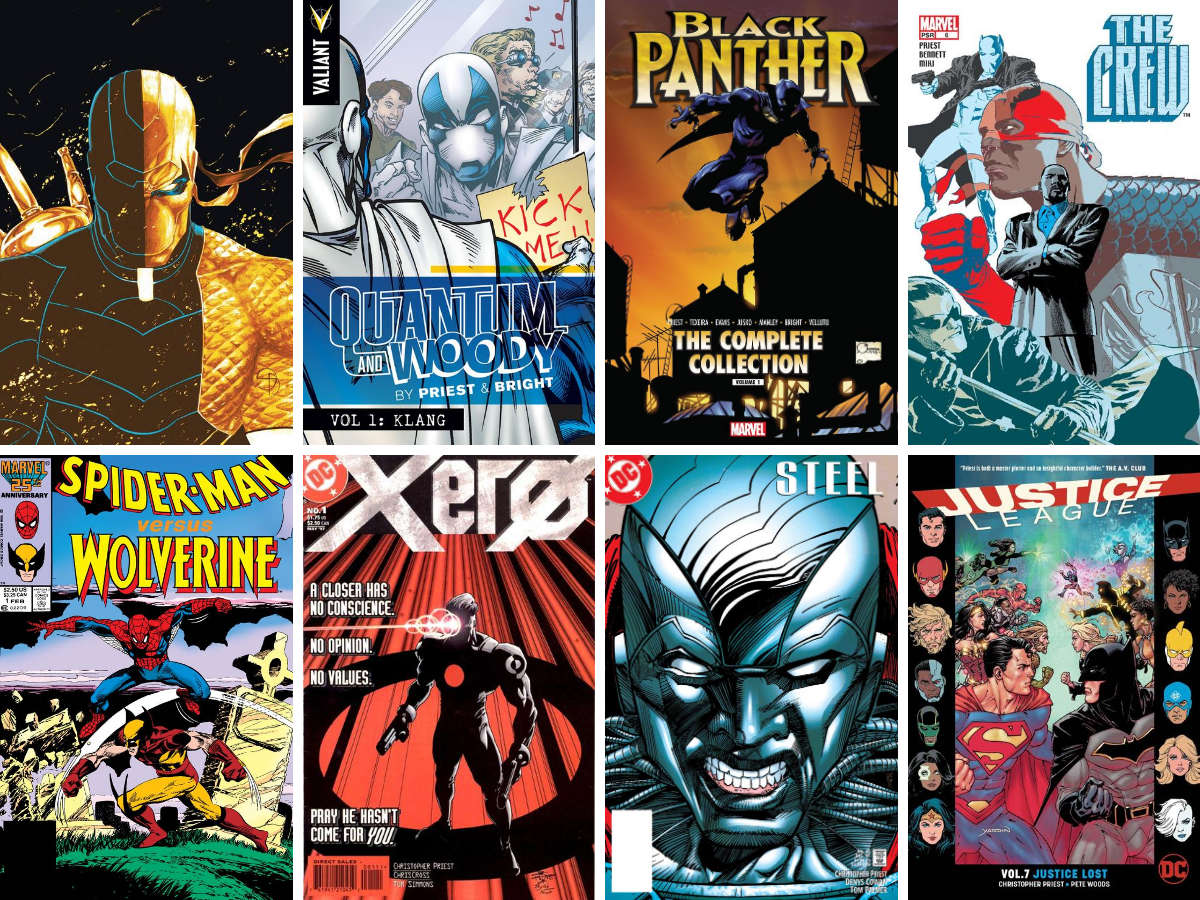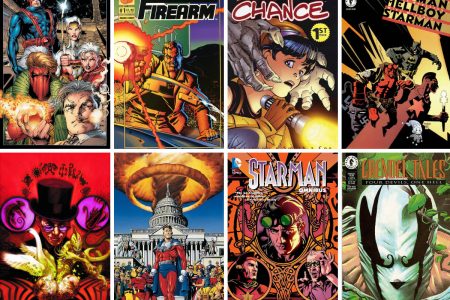My Writer Top Five series of posts is about writers of comic books whose work I’ve enjoyed (initiated by a post where I listed the writers with the most comic books in my collection at the time). I have started with writers outside the top 10 in that list, but it seemed appropriate to venture into the top 10 after my post on black comic book creators waxed lyrical about him already: Priest (aka Christopher J Priest, formerly known as Jim Owsley).
Before I list my favourite five comic books by a particular writer, I try to summarise their life up to that point, but it’s going to be tougher with Priest because his life has been more complicated, as can be seen by his list of names (I’ll refer to him as Priest throughout because it’s the name I associate with him). Jim Owsley was the first editor and staff writer in mainstream comic books who was African American, starting at Marvel in 1979 as an editor at the age of 22 and as a writer in 1983 with The Falcon mini-series.
He would eventually become editor of the Spider-Man books (a painful experience for him, which he believes he shouldn’t have been given the job because he was too young, as he discusses on his old website) and write Power Man and Iron First and the successful Spider-Man versus Wolverine book in 1987. However, when he wasn’t offered the chance to write a sequel to Spider-Man versus Wolverine, he decided to quit Marvel and move to DC in 1988. However, while writing some Green Lantern books, he became frustrated by the experience and went off to become a bus driver.
Priest would be lured back to DC (and would change his name at the same time) a few years later, and he would write various books, but at the same time he was also co-creating Milestone, ‘first nationally distributed mainstream super-hero comic book line owned and operated by African Americans’. He describes himself as the Pete Best of Milestone because he decided to step away at the last minute due to personal reasons before the contract with DC, but he was a significant part of a significant comic book company. After that, Priest would write many comic books at DC, including The Ray, Justice League Task Force, Steel, XERØ, as well as co-creating the wonderful Quantum and Woody at Acclaim Comics with MD Bright. But it would be in 1998 that Priest changed what he was known for, with the reboot of Black Panther at the Marvel Knights imprint, where Joe Quesada and Jimmy Palmiotti gave him free reign to do what he wanted with a character he thought of as boring. His 5-year run changed how T’Challa was seen and had a significant impact in the industry and in the film version of the character.
Despite this, life never ran smooth for Priest – the mishandling of XERØ at DC meant that he left the company and didn’t return until a few years ago, and he felt sidelined at Marvel despite the success of Black Panther, never getting asked to be on the big books (he would talk about the curse of Priest, writing books that would be cancelled: Deadpool, Ka-Zar, The Crew) and feeling that he’d become a ‘black writer’ instead of just a writer. Priest walked away from comic books for a decade, becoming a pastor, being a musician, and developing websites for churches. He returned for a Quantum and Woody book with MD Bright in 2015, but it would be DC that lured him back full time with the offer of writing Deathstroke (he admits that the offer of writing a white character was what did it), which he did to commercial and critical success, even getting the chance to work on Justice League for a too-short run in 2017/2018.
He’s currently writing Vampirella and a spin-off title, Sacred Six, at Dynamite Entertainment; the world of comic books is better with him in it. He writes with intelligence, ensuring you have to pay attention when reading his books; his work is full of sharp thinking about the state of politics and the complexity of modern life; he doesn’t set out to tackle race in his books but, when he does, it is with power and insight. Also, I highly recommend reading his websites (the old one and the new one) for extremely honest blog posts about his time working in comic books and the experiences he has survived.
Finally, on to my favourite five comic books written by Priest:
5. The Crew
It’s only seven issues (it was cancelled before the first issue came out) but this was Priest doing a book that was the same as The Wire, with individuals who aren’t really a team investigating crimes in a fictional neighbourhood in Brooklyn where gentrification has created a gated community and all criminal elements have been moved to one area (called Little Mogadishu, or The Mog). The team was James ‘War Machine’ Rhodes, Kasper ‘White Tiger’ Cole, Danny ‘Junta’ Vincent and Josiah ‘Justice’ X (the genetically engineered son of Isaiah Bradley, the black Captain America from Truth: Red, White and Black); Priest said that the film Three Kings was the biggest inspiration, about characters acting out of self-interest coming together to do something better. It had excellent art from Joe Bennett and it’s a great shame that the book wasn’t given the support it needed to last longer.
4. Steel #34–52
Priest described this as his take on a dysfunctional Superman and family, with great art from Denys Cowan (who Priest says drew John Henry Irons as Dwayne McDuffie, which gave Priest the hook he needed to write the character), and the wonderfully named bad guy, Dr Villain (‘It’s WILL-hayne. It’s French.’). Priest and Cowan worked some magic on the replacement Superman to provide some entertaining stories with a bit of grit and a lot of heart.
3. XERØ
A sign that I enjoyed XERØ is that I had a letter published in the book; what I didn’t realise was the difficulties Priest had in getting the book to be the way he wanted and the troubles he had behind the scenes (read here for all the horrific detail). Despite all this, I love this book about a black super-spy who is a famous basketball player by day but does his spy work dressed as a white guy, with all the inherent drama and tension involved, with some fantastic art from ChrisCross, and wish it had been better supported by the people in charge at DC.
2. Black Panther
When I think of T’Challa, the Black Panther, I think of the Priest run; he didn’t create the character, but he redefined him for a new audience without losing what had gone before, applying a new filter and injecting a healthy dose of humour and politics. Priest also made an important feature of the fact that T’Challa is king of a sovereign nation and the impact that has on his daily life and his life as a ‘superhero’. He didn’t shy away from the Marvel universe or Black Panther’s history within it, but he realigned it with a perspective that hadn’t been applied to the character before, making for fascinating reading. For me, the definitive Black Panther run.
1. Quantum and Woody
It’s not because I had a letter published in Quantum and Woody that it just pips Black Panther to the top spot. Quantum and Woody was an action-buddy comic book that didn’t sell well but was a fantastic book from a small company that was funny but also incredibly insightful and pushed boundaries when talking about race. It introduced the Priest trait of the fractured timeline, it reversed the usual trope of the comic relief being the black guy, it had a goat as a mascot. The World’s Worst Superheroes (a tagline Priest didn’t like) were like no other and the book was consistently one of the best books coming out at the time. It was so good that I bought the trades as well as the single issues, something that I do not do.




